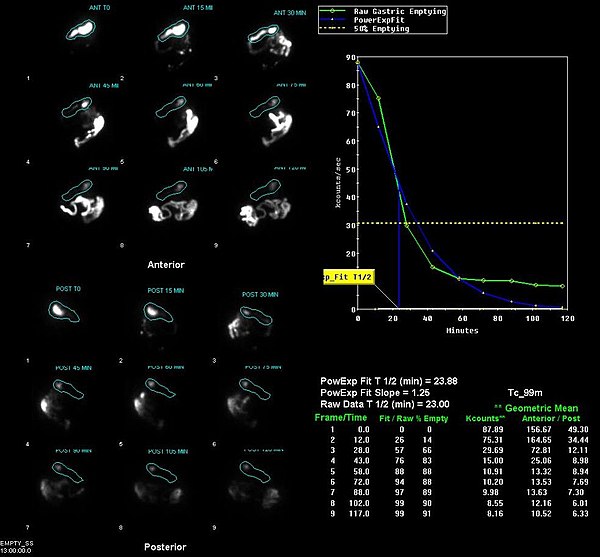| Gastric emptying study | |
|---|---|
 Example gastric emptying images
Example gastric emptying images | |
| Synonyms | Gastric emptying sccan, gastric emptying scintigraphy |
| ICD-10-PCS | CD171ZZ |
| OPS-301 code | 3-707 |
| LOINC | 39768-7 |
A gastric emptying study is a nuclear medicine study which provides an assessment of the stomach's ability to empty. It may be used if there are complications after gastric surgery, for gastric reflux, or suspected gastroparesis amongst other indications. Scintigraphy that uses gamma cameras to create two-dimensional images is generally regarded as the gold standard for gastric emptying.
Procedure
Having fasted for around four hours before the study, the patient is given a solid or semi-solid meal, such as scrambled eggs on toast or porridge, which has been prepared with a radiopharmaceutical component. Typically technetium-99m sulphur colloid or DTPA is used. Some studies may also involve a liquid component, which is labelled with indium-111 DTPA. Images are acquired with a gamma camera, initially dynamically and then at intervals for up to 2-3 hours.
Analysis
The stomach time-activity curve is produced from geometric mean of anterior and posterior imaging. Half-emptying time, the lag-phase duration for solid studies, and percentage of food left at various time points are calculated.
References
- ^ "Gastric Emptying Guideline" (PDF). BNMS. March 2015.
- Schmidt, Peter Thelin; Abrahamsson, Hasse; Dolk, Anders; Hausken, Trygve; Karling, Pontus; Lindberg, Greger; Nyhlin, Henry; Ohlsson, Bodil; Simrèn, Magnus; Sjölund, Kristina; Stotzer, Per-Olof; Törnblom, Hans (8 July 2009). "Methods to assess gastric motility and sensation". Scandinavian Journal of Gastroenterology. 43 (11): 1285–1295. doi:10.1080/00365520802240263. PMID 18618332. S2CID 24056361.
- Masaoka, Tatsuhiro; Tack, Jan (30 September 2009). "Gastroparesis: Current Concepts and Management". Gut and Liver. 3 (3): 166–173. doi:10.5009/gnl.2009.3.3.166. PMC 2852706. PMID 20431741.
- Zolle, Ilse (2007). Technetium-99m Pharmaceuticals: Preparation and Quality Control in Nuclear Medicine. Springer Science & Business Media. p. 300. ISBN 9783540339908.
- ^ Donohoe, K. J.; Maurer, A. H.; Ziessman, H. A.; Urbain, J.-L. C.; Royal, H. D.; Martin-Comin, J. (19 August 2009). "Procedure Guideline for Adult Solid-Meal Gastric-Emptying Study 3.0". Journal of Nuclear Medicine Technology. 37 (3): 196–200. doi:10.2967/jnmt.109.067843. PMID 19692450.
- Seok, Ju Won (30 April 2011). "How to Interpret Gastric Emptying Scintigraphy". Journal of Neurogastroenterology and Motility. 17 (2): 189–191. doi:10.5056/jnm.2011.17.2.189. PMC 3093013. PMID 21602998.
- Watson, Nick (15 November 2013). Chapman & Nakielny's Guide to Radiological Procedures. Elvesier Health Sciences. p. 88. ISBN 9780702054792. Retrieved 22 December 2020.